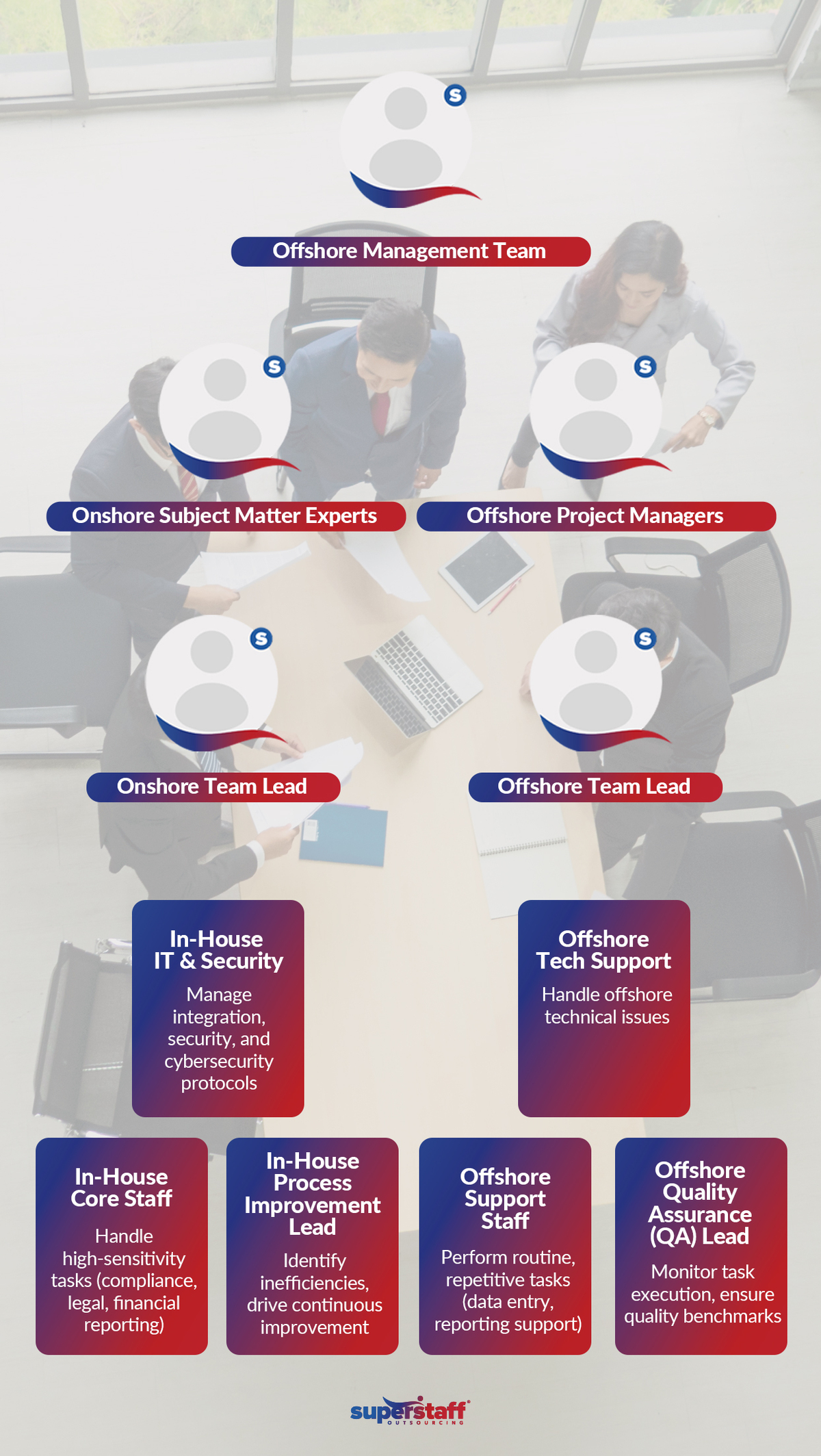
As your business grows and expands, you may consider hiring an offshore back-office team to streamline your operations and optimize costs.
Truthfully, partnering with an outsourcing provider can be an excellent way to strengthen your non-client-facing operations and create a more seamless experience for both employees and customers.
However, integrating offshore teams into your in-house staff can be complex, notably when figuring out how to remotely manage performance, quality, and productivity.
Comprehensive Guide to Integrating a Back Office Offshore Team Into Your In-House Operations
This guide will outline the ideal blended structure that ensures seamless integration between your in-house and outsourced operations. We’ll provide a clear framework for businesses like yours to successfully manage and collaborate with offshore back-office teams while maintaining efficiency and communication.

Team Leadership and Management Layer
Previously, back office functions were performed in-house, but the rise of outsourcing over the past few decades has created a shift in the global workplace. Today, more and more companies are choosing to delegate all or parts of their administrative and support operations to offshore teams. Doing so allows them to maximize productivity and efficiency while cutting costs.
If you want to work with back-office outsourcing companies but are unsure how to integrate their offshore team properly with your in-house one, start by familiarizing yourself with the team leadership and management layer. You’ll need at least two team leaders to manage your back-office department, one for your offshore team and another for your in-house (and overall) operations.
Offshore Team Lead
First, let’s discuss the offshore team lead and what they’ll do for you. Since keeping track of your outsourced team’s progress remotely can be challenging, you’ll need someone onsite to oversee your offshore back-office operations and ensure their work aligns with your in-house goals and targets.
The offshore Team Leader (TL) will act as the direct point of contact between you and your outsourced team. They monitor your offshore specialists’ performance and progress, ensuring daily tasks and crucial metrics are met. The offshore TL will report directly to your in-house lead and will be responsible for handling all local talent management issues.
In-House Team Lead
While your offshore TL monitors your back office outsourcing team and their performance, your in-house TL is in charge of overseeing your entire administrative and support operations, ensuring both teams comply with company requirements and remain aligned with overall goals.
In addition to monitoring the entire department, they’ll also handle performance reviews for each team member, address major escalations and conflicts, and make strategic decisions about maximizing productivity and streamlining overall operations.
How To Ensure a Successful Partnership Between Your In-House and Offshore Team Lead
Successful integration begins with a strong leadership structure that ensures alignment and accountability across both teams. At the start of your outsourcing relationship, make sure to establish clear roles and responsibilities for your in-house and offshore team leads so they can ensure proper organization, more precise division of tasks and assignments, and easier collaboration.
Frequent communication is also necessary for coordinating efforts and ensuring alignment on goals and expectations. The offshore TL must send regular reports on their team’s progress, providing relevant feedback and updates to ensure that performance standards are upheld and all members work towards a common goal. For the in-house TL, practicing cultural awareness and understanding is also vital to facilitate a seamless partnership.
Operations and Process Ownership
With leadership in place, the next step is establishing ownership of key processes and responsibilities. Developing a strong “process ownership” culture promotes accountability and ensures streamlined operations. Process owners are the individuals or teams in charge of managing and enhancing overall business processes.
A strategic approach to back office outsourcing involves assigning end-to-end process ownership to global leaders who oversee the design, technology integration, and service delivery. This model helps eliminate bottlenecks, enhance collaboration, and maintain cost efficiency while boosting compliance. A well-defined ownership structure encourages continuous improvements, aligning back office operations with broader business objectives. By establishing clear accountability, companies can optimize their financial performance and adapt more efficiently to market changes through streamlined governance and execution.
When employing back-office outsourcing services, you’ll need a solid process ownership foundation to maintain efficiency, optimize task delegation, and facilitate continuous improvement. This is where your in-house subject matter experts and offshore process managers will come in handy.
In-House Subject Matter Experts (SMEs)
Before you can execute and optimize your processes, you’ll need dedicated subject matter experts who are intimately familiar with your business, workflows, and industry. SMEs are individuals or teams with specialized expertise and knowledge, often developed through years of experience and continuous education in their field. Ideally, your subject matter experts should be in-house professionals with vast knowledge of your core processes and workflows.
Your in-house SMEs should train, onboard, and guide your back-office outsourcing team over the course of your partnership to help them better understand and integrate into your workflows. These individuals will act as a bridge between your in-house and outsourced processes, ensuring all systems are well-understood and implemented.
Offshore Process Managers
Once your in-house SME has trained your offshore employees, onsite process managers will be responsible for managing day-to-day operations. Their goal is to ensure that the work performed by your outsourced team aligns with the SME’s guidance and is compliant with process requirements and industry standards. These offshore professionals play a vital role in efficiently adapting and applying in-house processes to local practices.
Ensuring a Seamless Collaboration Between In-House SMEs and Offshore Process Managers
To prevent operational bottlenecks, in-house and offshore teams must have clearly defined responsibilities, assigned and monitored by process managers and approved by the SMEs. Since in-house SMEs have in-depth knowledge and experience with the organization’s workflows and systems, they must work directly with the process manager when training the offshore team on process nuances.
In addition to providing standardized training, SMEs and process managers must document and record all necessary processes and workflows for greater accountability and transparency. Robust documentation also helps facilitate remote knowledge transfers, which is critical for sustaining operational efficiency amid potential staffing changes.
Finally, having continuous feedback loops and mechanisms can be crucial for a successful back-office outsourcing partnership. This way, process managers can share updates or concerns regarding process implementation, and SMEs can relay changes and improvements that need to be made.
Core Back-Office Teams
Once processes are defined, it’s crucial to identify which tasks best suit each team to ensure a streamlined and efficient back office. Even though both teams handle administrative and non-client-facing functions, some tasks may still be better suited to one location over the other.
To create the ideal blended team structure, you must identify which roles and responsibilities are best kept in-house and which can be handled by an offshore back-office services provider. Here are our recommendations for how to delegate tasks in a way that maximizes the strengths of each location:
In-House Core Staff
Since your in-house staff will work in the same country and time zone as your core operations, they may be best suited for handling high-sensitivity tasks requiring proximity to your main office or stakeholders. Some examples include financial reporting and legal functions.
For example, in-house back-office workers will have more extensive knowledge of your nation’s regulatory compliance and legal standards than an offshore team. As such, letting them handle legal document preparation and research can be a good idea.
Offshore Support Staff
With your in-house team taking care of highly sensitive or location-dependent core tasks, your offshore staff can provide necessary administrative support. Offloading routine and repetitive tasks to your outsourced team can allow your in-house specialists to free up time and resources to focus on strategic initiatives. Some functions you can delegate offshore include data entry, virtual assistant services, customer invoicing, and reporting support.
Optimizing Task Delegation Between In-House and Offshore Staff
Task distribution should capitalize on the strengths of both teams, ensuring efficiency without compromising sensitive functions. This is why we recommend delegating routine, repetitive tasks to your offshore staff while keeping high-value and sensitive tasks in-house.
This tiered approach ensures that the offshore team contributes to operational efficiency and strengthens your back office without compromising on critical or sensitive functions. However, for this structure to work seamlessly, you must invest in effective communication tools, allowing in-house and outsourced professionals to share knowledge, collaborate, and stay aligned on business goals.
Communication and Collaboration Tools
A robust digital infrastructure is critical to overcoming geographical barriers between your in-house and outsourced teams. To strengthen your back office, offshore and in-house specialists must work together to create an integrated technology and communications policy, allowing your company to leverage the latest advancements for seamless teamwork and collaboration. Here’s how:
In-House IT and Security
To prevent data breaches and other cybersecurity concerns, we recommend keeping your Information Technology (IT) specialists in-house, particularly those focusing on data protection and privacy. Your in-house IT team will be responsible for managing the integration and security of your shared platforms to safeguard your networks and systems from data breaches.
Since your IT security team will be working with both in-house and outsourced staff, it is essential to train all employees on the best practices in cybersecurity and fraud prevention. Make sure to include stringent guidelines and protocols for handling sensitive client data and company information.
Offshore Tech Support
While your in-house IT team handles integration and cybersecurity issues, you’ll also need offshore tech support to help employees with troubleshooting and other technical concerns. Having a dedicated team ready to address and resolve technical problems offshore can minimize downtime and ensure all communication platforms remain functional.
Maximizing the Use of Digital Collaboration Tools
Now that you have two teams maintaining your digital infrastructure, one focused on data protection and the other on technical issue resolution, your organization can safely and effectively use technologies and software to maximize remote collaboration. Using communication tools like Slack, Asana, or Microsoft Teams is essential to bridge the gap and facilitate smooth daily operations between the two teams.
Continuous Improvement and Feedback
With communication tools in place, the next focus should be continuous improvement and quality management. Remember: The most successful businesses don’t remain stagnant. They must continually assess their operations, refine their processes, and make room for innovation and sustainable growth.
A McKinsey study found that organizations prioritizing continuous improvement reaped a 20% increase in productivity. In the long run, making regular improvements can also boost competitiveness and give companies an edge over other key players in their industry.
To achieve this, you’ll need team leaders focused on optimizing your workflows and improving the performance of your workforce. If you want to make the most of your in-house and back-office outsourcing teams, we recommend establishing these two key roles:
In-House Process Improvement Lead
Your company should strive for continuous process improvement to facilitate sustainable growth, and we recommend keeping this function in-house. Having a dedicated Process Improvement Lead can help you identify areas of your operations that can be further enhanced or optimized, establishing opportunities for creative problem-solving and innovation.
This in-house professional identifies inefficiencies and drives continuous improvement efforts within your blended team. Their responsibility is to regularly assess the efficiency and effectiveness of your existing workflows and systems, searching for bottlenecks, flaws, or other areas that can be refined or upgraded.
Offshore Quality Assurance (QA) Lead
Beyond continuously improving processes, your company should strive to enhance employee performance. This is where your offshore Quality Assurance (QA) lead will be of service.
Offshore QA leads are responsible for monitoring the performance and progress of your outsourced team, ensuring they meet the quality benchmarks and KPIs set by your in-house professionals. They conduct regular performance reviews and evaluations of each team member, providing feedback to help improve service quality and conducting tailored interventions (such as Performance Improvement Plans) when necessary.
Effectively Collaborating for Continuous Improvement and Innovation
Continuous improvement is vital for maintaining the efficiency and quality of a blended team. Refining processes and enhancing employee performance are the key elements to facilitate this advancement.
As such, your in-house Process Improvement leads and offshore QA leads must communicate and collaborate closely to ensure the success of all improvement and innovation programs. Regular feedback sessions and KPIs, tracked across both teams, will be necessary to continuously refine workflows and address any gaps in process or communication. Doing this can help both teams stay aligned on overall company goals.

Measuring Success and Adjusting the Blended Team Structure
With all structures and systems in place, the final step is measuring success and making continuous adjustments. Tracking progress and performance and making room for improvements help ensure your blended team structure’s long-term success and viability.
It’s not enough to simply guess whether your in-house + back-office outsourcing integration is working as intended. You must use data-driven strategies to measure their performance individually and as a whole, compare them against relevant benchmarks and targets, and make process improvements or adjustments when necessary.
Here are the steps you can take to evaluate and refine your blended team structure:
#1: Use KPIs to track productivity, quality of work, and team collaboration.
Before improving your blended team structure, you must gather and analyze their performance data over a set period. For instance, one of your goals for working with a back-office offshore team is to improve operational productivity.
To find out if integrating them into your in-house operations achieved your goal, compare your in-house team’s previous performance to the overall performance of both teams together. This will give you a clearer picture of whether the blended team structure maximizes and strengthens your back-office operations.
Use both qualitative and quantitative metrics to assess the team’s efficiency, communication, and overall performance. Qualitative measures include KPIs and other statistic-driven criteria, while qualitative measures include asking for feedback directly from your team through surveys and interviews.
#2: Conduct regular team reviews and make adjustments based on performance feedback.
Once you’ve collected enough data about your team’s quality of work and productivity, your next step should be to conduct regular team reviews. You can start by performing individual employee reviews to help each person identify their strengths and weaknesses, identify areas for improvement, and make plans to refine their performance.
Then, move forward with team-wide reviews. Assess the performance of your offshore and in-house team individually and as a whole. Ask for feedback about any concerns, suggestions, ideas, or possible process improvements that could benefit them as they handle their daily workload and enhance your overall operations.
#3: Encourage collaboration between in-house and offshore teams to refine workflows.
Finally, fostering a positive relationship between your in-house and offshore teams can be crucial for your back-office operations’ long-term effectiveness, productivity, and growth.
Encourage them to communicate and collaborate regularly by leveraging task assignment and tracking tools, video conferencing software, and virtual messaging applications.
This regular collaboration between the two teams can lead to process improvements and workflow refinement as all team members come together to express concerns, share ideas, and facilitate creativity and innovation. With a well-integrated team, companies can leverage in-house and offshore strengths for long-term success.
Strengthen Your Operations By Hiring the Back-Office Offshore Professionals at SuperStaff
When leadership, processes, task allocation, communication, and continuous improvement are aligned, a well-integrated offshore and in-house team structure can significantly improve efficiency, reduce costs, and ensure business scalability.
If you’re ready to integrate your offshore and in-house teams, you must assess your current structure and identify areas for collaboration improvement.
Then, get in touch with the BPO professionals at SuperStaff for in-depth guidance on the next steps in your back-office outsourcing journey.
We’ll help you evaluate your existing operations, identify areas of your business where outsourcing can most benefit you, and create a customized solution that meets your needs and goals.
Contact us for a quick consultation today to get started!






